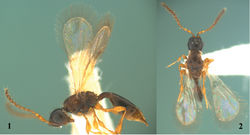Calogalesus sinicus
| Notice: | This page is derived from the original publication listed below, whose author(s) should always be credited. Further contributors may edit and improve the content of this page and, consequently, need to be credited as well (see page history). Any assessment of factual correctness requires a careful review of the original article as well as of subsequent contributions.
If you are uncertain whether your planned contribution is correct or not, we suggest that you use the associated discussion page instead of editing the page directly. This page should be cited as follows (rationale):
Citation formats to copy and paste
BibTeX: @article{Feng2016ZooKeys, RIS/ Endnote: TY - JOUR Wikipedia/ Citizendium: <ref name="Feng2016ZooKeys">{{Citation See also the citation download page at the journal. |
Ordo: Hymenoptera
Familia: Diapriidae
Genus: Calogalesus
Name
Calogalesus sinicus Feng, Notton & Xu sp. n. – Wikispecies link – ZooBank link – Pensoft Profile
Material examined
Holotype, ♀: CHINA: Yunnan, Zhaotong, Huanghua town (N27°59', E103°33'), 10.VIII.2012, Shi-wen Yang leg. Paratypes: 16 ♀♀, Yunnan, Zhaotong, Huanghua town (N27°59', E103°33'), 10.VIII–26.X.2012, Shi-wen Yang leg.; 37 ♂♂: Yunnan, Zhaotong, Huanghua town (N27°59', E103°33'), 10.VIII–26.X.2012, Shi-wen Yang leg.
Description
Female (Figs 1–4). Holotype. Body length 1.2 mm. Fore wing length 1.0 mm. Colour. Head blackish-brown, mandibles brown. Antennae yellowish-brown. Mesosoma brown. Legs and tegulae yellowish-brown. Wings hyaline, with veins yellowish-brown. Metasoma brown, with apex yellowish-brown.
Head. Head subcircular in dorsal view, subtriangular in lateral view; smooth and shiny, with sparse hairs. Mandible tridentate, strongly projecting, beak-like. Labrum subtriangular. Clypeus highly convex. Eyes oval, slightly bulging laterally, with sparse hairs. Malar sulcus distinct. Frons with two sharp points and longitudinal ledges above upper eye orbit. Antennal shelf strongly projecting. Antenna 12-segmented (Fig. 3), with hairs slightly longer than width of antennal segment. Relative proportion of length to width of antennal segments: A1 (24:6); A2 (7:5); A3 (10:4); A4 (7:4); A5 (7:5); A6 (7:5); A7 (7:5); A8 (7:6); A9 (7:6); A10 (7:6); A11 (7:6); A12 (8:5). Eye 1.5 times as long as wide, 2.5 times as long as malar space. Ocelli with POL:OOL=5:12. Occipital flange moderately developed and step-like. Genal ridge with tufts of hairs.
Mesosoma. Mesosoma as wide as head in dorsal view. Cervix distinct. Pronotum smooth and shiny. Pronotal shoulders almost rounded. Epomium indistinct. Mesoscutum smooth and shiny, with sparse hairs. Notauli deep and posteriorly convergent, incomplete, reaching 0.90 length of mesoscutum, not reaching transscutal articulation. Humeral sulcus distinct. Mesoscutellum subtriangular, smooth and shiny, with two large foveae on anterior half and a row of small pits on the posterior margin. Mesopleuron smooth and shiny, with a groove beneath tegula. Sternaulus indistinct. Metanotum and metapleura reticulate rugose. Propodeum reticulate rugose. Dorsal surface of propodeum with one median longitudinal keel. Plica distinctly projecting posteriorly. Posterior surface of propodeum carinate and emarginated, descending abruptly and steeply with two postero-lateral teeth in lateral view. Wings (Fig. 4) fully developed, with long marginal cilia. Fore wing with two elongate hairless zones basally; costal, subcostal, marginal and stigmal veins present, basal and postmarginal veins absent. Venation extending to half length of fore wing. Stigmal vein elongate, 0.6 times as long as marginal vein. Hind wing with submarginal vein complete. Femora and tibiae clavate. Fore tibia without an outwardly directed spine.
Metasoma. Petiole sparsely hairy, shiny, rugose with longitudinal striae, distinctly curved in lateral view; 2.6 times as long as wide in dorsal view; 2.3 times as long as high in lateral view. Gaster moderately compressed laterally. T2 enlarged, 2.6 times as long as wide in dorsal view, and covering 0.65 length of gaster in dorsal view. Anterior margin of T2 straight, without furrow or emargination. Metasomal tip conical.
Variation. Body length 1.1–1.4 mm (n=17). Fore wing length 1.0–1.3 mm (n=17).
Male (Figs 5–7). Body length 1.0–1.3 mm (n=37). Fore wing length 0.8–1.2 mm (n=37). Antenna 14-segmented (Fig. 6), with hairs slightly longer than width of antennal segment. Relative proportion of length to width of antennal segments as follows: A1 (23:4); A2 (7:4); A3 (10:3); A4 (8:3); A5 (7:4); A6 (7:4); A7 (7:4); A8 (7:4); A9 (7:4); A10 (7:4); A11 (7:4); A2 (7:4); A3 (7:4); A14 (8:4). A4 not modified. Metasomal tip blunt. Other characteristics as for females.
Biology
Host unknown. This species was collected by placing 500 yellow pan traps in a Chinese prickly ash (Zanthoxylum bungeanum Maxim.) orchard (Figs 8, 9) from 10.VIII.2012 to 26.X.2012. Specimens were picked up every day.
Distribution
Known from a single location in China (Yunnan).
Remarks
This new species can be separated from the two described species, Calogalesus parvulus Kieffer, 1912 (Fig. 10), and Calogalesus malabaricus Rajmohana & Narendran, 2006, by the characters given in the key. In all previous descriptions of Calogalesus (Masner and García Rodríguez 2002[1]; Rajmohana et al. 2013[2]), state that the mandible are bidentate, however the new species has tridentate mandibles, so we have revised the generic diagnosis accordingly.
Etymology
The new species is named after the country of the type locality, China.
Original Description
- Feng, J; Notton, D; Xu, Z; 2016: A new species of Calogalesus Kieffer from China (Hymenoptera, Diapriidae) with a key to World species ZooKeys, (626): 57-65. doi
Images
|
Other References
- ↑ Masner L, García Rodríguez J (2002) The genera of Diapriinae (Hymenoptera: Diapriidae) in the New World. Bulletin of the American Museum of Natural History 268: 1–138. doi: 10.1206/0003-0090(2002)268<0001:TGODHD>2.0.CO;2
- ↑ Rajmohana K, Poorani J, Shweta M, Malathi C (2013) A pictorial guide to Diapriinae genera of India. Web page. Zoological Survey of India, Calicut, Kerala & National Bureau of Agricultural Insect Resources. http://www.nbair.res.in/Diapriinae/index.php [accessed 16 February 2016]





